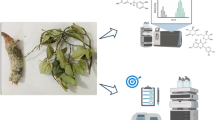Abstract
The UV–Vis absorbance method is modified as a faster and cheaper means for the study of extraction of natural dyes from plant sources. The method was validated using standard methods of analysis viz: egg albumin precipitation and aluminium colorimetric methods for quantification of tannins and flavonoids respectively. The solvents selected for extraction of dye from plant samples included; distilled water, methanol (5% v/v), ethanol (5% v/v), acidified water pH 3.5 (acidified with acetic acid), and sodium bicarbonate solution (0.1% w/w). Qualitative UV scans were conducted on dye extract of each plant obtained from previously dyed cotton fabrics and wavelengths at maxima for extract of each plant was recorded. In the validation step, data obtained from the modified UV absorbance method were compared to that obtained from standard methods. The modified and validated method was used for the study of extraction output of dye from selected dye-yielding plants using the selected solvents. Extracts from the selected plants registered absorbance maxima at wavelengths unique to each viz: A. coriaria (291 nm), V. paradoxa (294 nm), M.lucida (300 nm) and H. madagascariensis (428 nm) these were employed in setting the analytical instrument. Data obtained from the modified method closely correlated to that from egg albumin and aluminium colorimetric methods with R2 = 0.989 and 0.9258 respectively. The modified method registered minimal errors in the range of (0.3–8.7%) for the A. coriaria extracts and errors of (2.3–6.7%) for M. lucida extracts. The errors recorded from the standard methods were in the range of (2.1–7.9%) and (2.29–6.8%) for egg albumin precipitation and aluminium colorimetric methods respectively. Both the standard and the modified methods exhibited similar accuracy of analysis. Through the application of the modified method, sodium bicarbonate solution (0.1% w/w) was identified to give the best dye extraction output. This modified method gives a faster and cheaper means for quantitative analysis where data is required rapidly for decision making.


Similar content being viewed by others
Availability of data
All information obtained during the study is available to all who have interest.
References
Ferreira ESB, Hulme AN, Macnab H, Ouve A (2004) The natural constituents of historical textile dyes. Chem Soc Rev 33:329–336
Anderson B (1971) Creative spinning, weaving and plant dyeing. Angus and Robinson, Singapore, pp 24–28
Singh V, Singh RV (2002) Healthy hues, down to earth. Gen Rep 11:25–30
Bechtold T (2006) Extraction of natural dyes for textile dyeing from coloured plant wastes released from the food and beverage industry. J Sci Food Agric 86:233–242
Pubalina S (2020) A review on application of natural dyes on textile fabrics and its revival strategy. In: Chemistry and technology of natural and synthetic dyes and pigments. 10.5772/intechopen.90038
Sheikh J, Jagtap PS, Teli MD (2016) Ultrasound assisted extraction of natural dyes and natural mordants vis a vis dyeing. Fibers Polym 17:738–743
Teli MD, Sheikh J, Jagtap PS (2013) Microwave Assisted extraction of natural dyes and natural mordants vis a vis dyeing. Asian Dyer. https://doi.org/10.1007/s12221-016-5031
Khan AA, Iqbal N, Adeel S, Azeema M, Batoolal F, Bhatti LA (2014) Extraction of natural dye from red calico leaves: gamma ray assisted improvements in colour strength and fastness properties. Dyes Pigm 103:50–54
Geetha B, Judia Harriet Sumathy V (2013) Extraction of natural dyes from plants. IJCPS 1(8):502–509
Basic UV-Vis Theory (2000) Concepts and applications. ThermoSpectronic, A Guide, p 1
Hatamnia AA, Abbaspour N, Darvishzadeh R (2014) Antioxidant activity and phenolic profile of different parts of Bene (Pistacia atlantica subsp. kurdica) fruits. Food Chem 145:306–311
Atlabachew M, Chandravanshi BS, Redi M (2014) Selected secondary metabolites and antioxidant activity of Khat (Catha edulis Forsk) chewing leaves extract. Int J Food Prop 17(1):45–64
Deo HT, Roshan P (2004) Natural dyeing of derim with eco-friendly mordant. ITB Int Textile Bull 5(50):66–70
Katy H (1997) Cultivation and Extraction of Natural Dyes for Industrial Use in Textile Production. Bio Mat Net, Inter,AIR 2-CTT94- 80.
Zhang X, Laursen RA (2005) Development of Mild extraction methods for the analysis of natural dyes in textiles of historical interest using LC-diode array detector-MS. J Anal Chem 77:2022–2025
Woisky R, Salatino A (1998) Analysis of propolis: some parameters and procedures for chemical quality control. J Apic Res 37:99–105
Kabir F, Bhuiyan MMH, Manir MS, Rahaman MS, Khan MA, Ikegami T (2019) Development of dye-sensitized solar cell based on combination of natural dyes extracted from Malabar spinach and red spinach. Results Phys 14:102474
Chang C, Yang M, Wen H, Chern J (2002) Estimation of total flavonoid content in propolis by two complementary colorimetric methods. J Food Drug Anal 10:178–182
Zumahi, S. M. Amir-Al, Hossain, Md Kamal, Abser, M., Matin, Rummana, Bashar, M., Ahmed, Farid, Hossain, Md. Abul, (2018). Extraction of different natural Dyes from Flower Plants. International Conference on Recent Advances in Mathematical and Physical Sciences. At: Jahangirnagar University, Savar, Dhaka, Bangladesh. https://doi.org/10.13140/RG.2.2.22055.65443
Mohnen D (2008) Pectin structure and biosynthesis. Cur Opin Plant Biol 2008(11):266–277
Sila D,N, Van Buggenhout S, Duvetter T, Fraeye I, De Roeck A, Van Loey A, Hendrickx M, (2009). Pectins in processed fruits and vegetables: Part II—Structure–function relationships. C R F S F S.
Acknowledgements
Recognition goes to Simon Peter a lab technician at Kyambogo University for his contribution in running the UV spectrophotometer. In a special way, thanks go to Dr. Justus Kwetegyeka the Dean of Faculty of Science, Kyambogo University for accepting a large part of the study at chemistry lab at Kyambogo. Appreciation goes to the African Development Bank (AfDB) for funding the research project
Funding
This research project was supported by the African Development Bank (AfDB) under staff development for Academic staff.
Author information
Authors and Affiliations
Corresponding author
Ethics declarations
Conflict of interest
There is no conflict of interest with respect to the study and the need to publish the work.
Rights and permissions
About this article
Cite this article
Loum, J., Byamukama, R. & Wanyama, P.A.G. UV–Vis Spectrometry for Quantitative Study of Tannin and Flavonoid Rich Dyes from Plant Sources. Chemistry Africa 3, 449–455 (2020). https://doi.org/10.1007/s42250-020-00135-6
Received:
Accepted:
Published:
Issue Date:
DOI: https://doi.org/10.1007/s42250-020-00135-6




